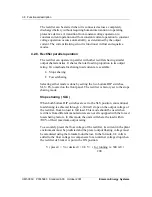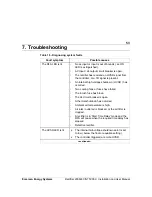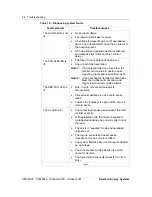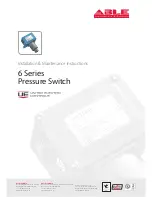
48 Operation
UM5C05C P0745680 Standard 6.00 October 2001
Emerson Energy Systems
Procedure 9 - Starting up the rectifier ( continued )
Step Action
23
Turn ON the other rectifiers in the system.
Setting the start-up delay
24
Use this feature to reduce the inrush currents when two or more
rectifiers are connected to a common ac input. Set the DIP switches
on the front panel for the required start-up delay, from 4 to 124
seconds ( see Table 13 ).
Adjusting the forced load sharing
25
If the forced share mode is chosen, adjust the float voltage of each
rectifier to the appropriate value plus 0.8 volts in slope share mode,
as described above. For example, to have a 52.1 V float voltage :
52.1 V +0.8 V = 52.9 V.
This compensates for the internal voltage drop when the dc breaker
of the rectifier is put in the ON position. Connect all the FS wires of
the rectifiers together and set the two bottom DIP switches, located
on the front panel, to FS for forced load sharing ( see Figure 10 ).
26
If the rectifiers are connected to the NT6C43PB board, in the cabinet
or frame option, the P1-17 signals from all the rectifiers are
automatically connected. After step 25 has been completed, the
rectifiers will automatically share the output current.
When forced load sharing is desired, but the NT6C43PB board is not
used or is bypassed, pins P1-17 of all the rectifiers must be made
common at a single point. This connection could be a splice
connection of all the P1-17 wires in the control cables, using a 2B16
splice from T&B ( or equivalent ) in the control panel.
The E1 terminal on the NT6C43PB board can be used when forced
load sharing is desired amongst rectifiers on two, or more, cabinets
or frames. In this case, the E1 terminal from all the cabinets or racks
must be daisy chained with metric No. 7 ( AWG 22 ) wire.
27
Repeat step 21, but in equalize mode, to verify that the current is
shared equally amongst the rectifiers when a remote equalize signal
is applied, or when all local FLOAT / EQL toggle switches are
toggled in the EQL position. If the current reading is too low, or is 0,
turn the EQL potentiometer clockwise until proper sharing is
achieved. If the current is too high, or if the rectifier is in the current
limit mode, turn the EQL potentiometer counterclockwise.
28
Deactivate the EQL mode to return to the normal float mode.
end















































